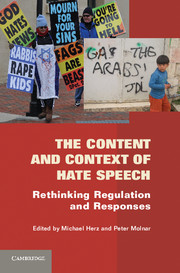Book contents
- Frontmatter
- Contents
- Contributors
- Foreword: Hate Speech and the Coming Death of the International Standard before It Was Born (Complaints of a Watchdog)
- Foreword: Hate Speech and Common Sense
- Acknowledgments
- Introduction
- Part I Overviews
- 1 Interview with Robert Post
- 2 Is There a Case for Banning Hate Speech?
- 3 Hate Speech
- 4 Interview with Kenan Malik
- 5 Hate Speech and the Demos
- 6 On American Hate Speech Law
- Part II Refinements and Distinctions
- Part III Equality and Fear
- Part IV International Law
- Index
- References
4 - Interview with Kenan Malik
Published online by Cambridge University Press: 05 June 2012
- Frontmatter
- Contents
- Contributors
- Foreword: Hate Speech and the Coming Death of the International Standard before It Was Born (Complaints of a Watchdog)
- Foreword: Hate Speech and Common Sense
- Acknowledgments
- Introduction
- Part I Overviews
- 1 Interview with Robert Post
- 2 Is There a Case for Banning Hate Speech?
- 3 Hate Speech
- 4 Interview with Kenan Malik
- 5 Hate Speech and the Demos
- 6 On American Hate Speech Law
- Part II Refinements and Distinctions
- Part III Equality and Fear
- Part IV International Law
- Index
- References
Summary
Peter Molnar: Would you characterize some speech as “hate speech,” and do you think that it is possible to provide a reliable legal definition of “hate speech”?
Keenan Malik: I am not sure that “hate speech” is a particularly useful concept. Much is said and written, of course, that is designed to promote hatred. But it makes little sense to lump it all together in a single category, especially when hatred is such a contested concept.
In a sense, hate speech restriction has become a means not of addressing specific issues about intimidation or incitement, but of enforcing general social regulation. This is why if you look at hate speech laws across the world, there is no consistency about what constitutes hate speech. Britain bans abusive, insulting, and threatening speech. Denmark and Canada ban speech that is insulting and degrading. India and Israel ban speech that hurts religious feelings and incites racial and religious hatred. In Holland, it is a criminal offense deliberately to insult a particular group. Australia prohibits speech that offends, insults, humiliates, or intimidates individuals or groups. Germany bans speech that violates the dignity of, or maliciously degrades or defames, a group. And so on. In each case, the law defines hate speech in a different way.
One response might be to say: Let us define hate speech much more tightly. I think, however, that the problem runs much deeper. Hate speech restriction is a means not of tackling bigotry but of rebranding certain, often obnoxious, ideas or arguments as immoral. It is a way of making certain ideas illegitimate without bothering politically to challenge them. And that is dangerous.
- Type
- Chapter
- Information
- The Content and Context of Hate SpeechRethinking Regulation and Responses, pp. 81 - 91Publisher: Cambridge University PressPrint publication year: 2012
References
- 3
- Cited by



